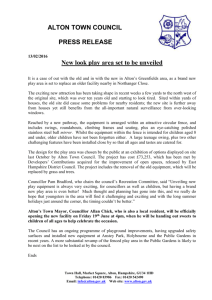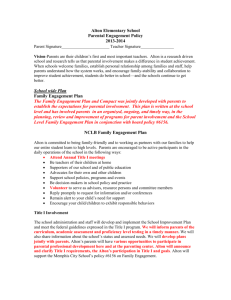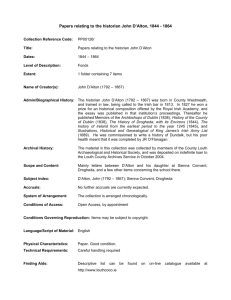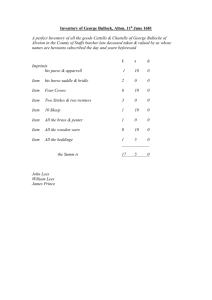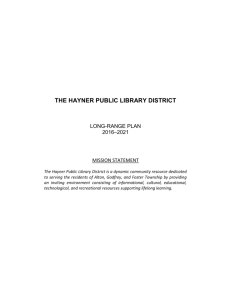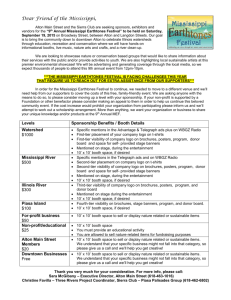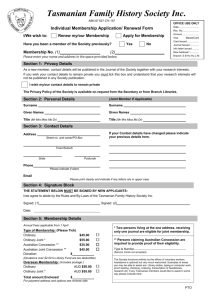coors brewers ltd, alton brewery
advertisement
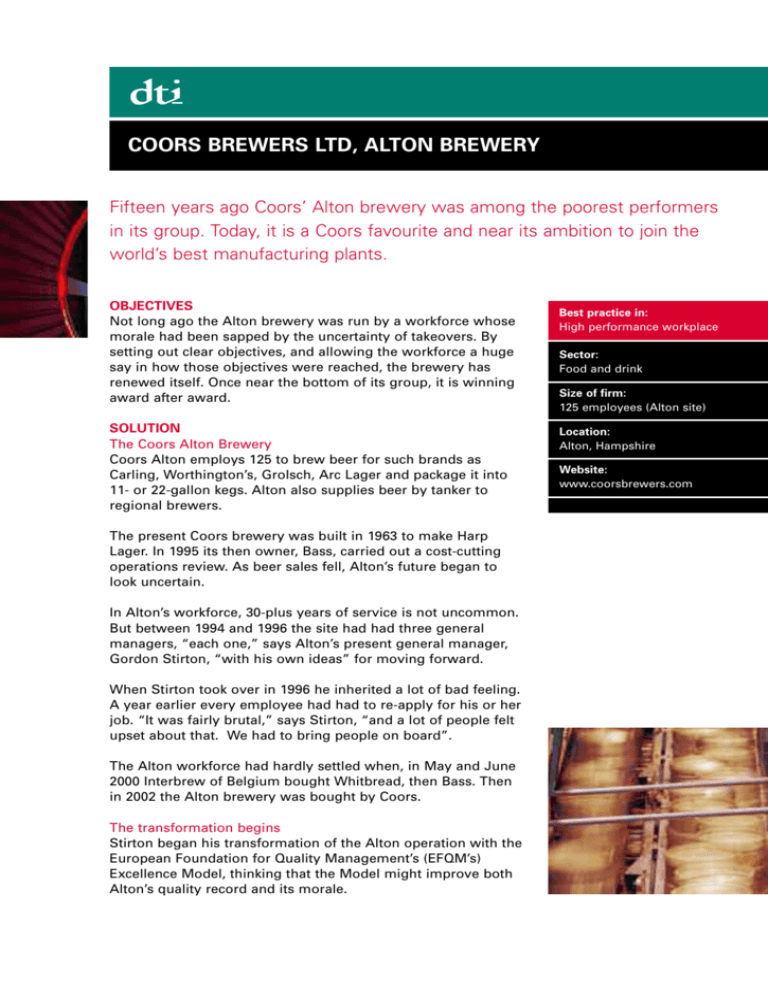
COORS BREWERS LTD, ALTON BREWERY Fifteen years ago Coors’ Alton brewery was among the poorest performers in its group. Today, it is a Coors favourite and near its ambition to join the world’s best manufacturing plants. OBJECTIVES Not long ago the Alton brewery was run by a workforce whose morale had been sapped by the uncertainty of takeovers. By setting out clear objectives, and allowing the workforce a huge say in how those objectives were reached, the brewery has renewed itself. Once near the bottom of its group, it is winning award after award. SOLUTION The Coors Alton Brewery Coors Alton employs 125 to brew beer for such brands as Carling, Worthington’s, Grolsch, Arc Lager and package it into 11- or 22-gallon kegs. Alton also supplies beer by tanker to regional brewers. The present Coors brewery was built in 1963 to make Harp Lager. In 1995 its then owner, Bass, carried out a cost-cutting operations review. As beer sales fell, Alton’s future began to look uncertain. In Alton’s workforce, 30-plus years of service is not uncommon. But between 1994 and 1996 the site had had three general managers, “each one,” says Alton’s present general manager, Gordon Stirton, “with his own ideas” for moving forward. When Stirton took over in 1996 he inherited a lot of bad feeling. A year earlier every employee had had to re-apply for his or her job. “It was fairly brutal,” says Stirton, “and a lot of people felt upset about that. We had to bring people on board”. The Alton workforce had hardly settled when, in May and June 2000 Interbrew of Belgium bought Whitbread, then Bass. Then in 2002 the Alton brewery was bought by Coors. The transformation begins Stirton began his transformation of the Alton operation with the European Foundation for Quality Management’s (EFQM’s) Excellence Model, thinking that the Model might improve both Alton’s quality record and its morale. Best practice in: High performance workplace Sector: Food and drink Size of firm: 125 employees (Alton site) Location: Alton, Hampshire Website: www.coorsbrewers.com “We’ve got almost everybody in this mindset – they want to be the best, they want to be number one, they want to win the European award.” GORDON STIRTON – GENERAL MANAGER However good the Excellence Model, the Alton operation was still incoherent and disorganised: “We were trying to get people to work together as a single team,” says Stirton. “But brewing did their own thing and packaging did their own thing.” So he combined the two operations under one manager with the objective of developing the two parts of the operation as partnerships. Staff were redeployed to make better use of their skills and aptitudes and to begin the formation of better functioning teams of flexible, multi-skilled people. Values and behaviours The next step was to establish a unified, site-wide system which gave every employee a personal development programme (PDP) and personal business objectives (PBOs). “That,” says business improvement manager Robert Parker, “has been in place, complete, since 1998.” Then, crucially, Alton set out its expectations for employee behaviour and attitude. Everyone would strive to meet what was expected of them as a company, as a team, and as individuals within the teams. And they would embrace the training needed to make these expectations a reality. To meet these expectations, Alton management and the team leaders developed a list of 18 behaviours that included being on time, willingness to change shifts, being friendly and approachable. Feedback about behaviour is through one-to-one appraisal and other meetings on site. Now, says Parker: “It’s been three-and-a-half years since I worried about who senior people were going to see when they went round the brewery. That’s a sea change. Now I just say, ‘Go where you want, talk to who you want’.” Cascade Alton is a strong supporter of both the balanced scorecard approach and Hoshin Kanri, a management technique which sets out rules for policy deployment – the cascade of policies and procedures from the top of an organisation to the bottom. The takeover by Interbrew and, two years later, sale of Alton to Coors meant management needed to give yet more direction and motivation. Over three weeks in 2001 Stirton and his colleagues held meetings for everyone at a local hotel. Together, management and workforce replaced an old, barelyknown mission statement with a simple vision: “To be the best” at everything they did. Four critical success factors, again derived collectively, would make the vision achievable: excelling in cost, quality and customer service, and having the best people: “One big brewery,” in the Alton mantra, “working together.” Since the workforce devised most of this, there has never been a problem about buy-in. Now Alton sets its objectives for the year ahead by melding Coors’s plant targets, reviewed quarterly, with its own. These objectives turn into performance measures to keep the site on course. And those feed into the PBOs to set out how each individual can contribute not just to their given role but to achievements over and above the daily job. PBO performance is part of the appraisal process. With the vision and values in place, Stirton and his team could set a plant-wide objective – to win the EFQM award in three years’ time. Team leaders Four years ago Alton saw the need to move to more flexible working (below). Flexibility’s big benefit would be reduced cost – especially valuable during the high-volume periods which coincide with the summer and winter holidays. In the mid-1990s Alton’s reliance on overtime was expensive. But flexibility would be impossible without first strengthening the role of the team leaders to help improve the performance and skills of everyone in their team. Alton mapped out a matrix of competences for every new team leader and now lists eight courses team leaders must complete to build their skills. In the last four years the emphasis in team leadership has moved strongly from supervision to coaching. Head office has helped Alton with team leader training and development. Team leaders now know how to run good appraisals and one-toone interviews, to monitor PBOs and core competences, and to instil Alton’s attitude and behaviour policy. Autonomous teams Alton could only capitalise on its team leaders’ rising capabilities if it won greater commitment from team members. It had to develop key skills within each team. So the next important step was to develop the teams and give them more responsibility. In 2002 Alton began what Parker calls “a big programme to train in flexibility, and it’s still rolling.” The aim is to encourage every team member to acquire as many relevant skills as possible. Now Alton’s flexibility allows it to meet shortages in packing staff by using brewing staff and vice versa. Flexible people make problems solvable. And flexibility, Parker adds, is a development opportunity: “Now they have the freedom to work in many roles in the plant the team members get more job satisfaction.” One Alton aim, for example, is to do maintenance autonomously. So the teams – leaders and members – are expected to develop basic engineering skills. As part of its commitment to continuous improvement, Alton expects employees to try to find process weaknesses and get to their root cause. Team members are now involved in shut downs and start ups at the beginning and end of the week. Not long ago this would have been unthinkable. Teams are also expected to deal with materials ordering, reconciliation and invoice matching. It is the team leader’s role to manage the resources on the team and release people for training and development. At night the plant now often runs without team leaders or management on site. Team leaders have taken over management’s on-call role and will go into the plant if needed. Continuous improvement Continuous Improvement too is driven by the team leaders. Their teams are expected to deliver CI in quality, cost, and customer service. Overall improvement performance is assessed against nine criteria in the Excellence Model. The plant holds weekly CI and partnership meetings. Though there are only a certain number of improvements Alton can make, one of the benefits of running a plant with only 125 people is that managers generally “know” what’s going on and what needs to be done. “If we had 700 people we might need additional methods,” says Parker. RESULTS In the mid-1990s Alton faced possible closure. Since then it has won one group quality award after another, despite tightening standards and has also achieved a number of external awards. It is setting ever higher targets and its workforce, proud of what it has done and might yet do, looks likely to achieve them. CHALLENGES Changing behaviours takes time, partly because people have to relearn what is appropriate. But Coors thinks it vital that its people realise that only certain behaviours will make it successful in years to come. Coors is also working to fully implement and verify people against SOPs, as the old work instructions were too long winded and people tended not to use them. THE LAST WORD “We’ve got almost everybody in this mindset – they want to be the best, they want to be number one, they want to win the European award. It’s the culture of winning: we want to be winners, and winners in absolutely everything.” says Stirton. This case study was sourced from the Cranfield School of Management. DTI is not responsible for the content of external websites and inclusion in, or exclusion from, the above list does not imply recommendation, endorsement or otherwise of any company, product or service. Remember that technologies and markets change rapidly so it is always wise to undertake your own independent research. For more information on Achieving best practice in your business: ● Visit our website at www.dti.gov.uk/bestpractice ● Call us on 0845 015 0010 to order from our range of free best practice publications or visit www.dti.gov.uk/publications ● Contact your local Business Link advisor by visiting the website at www.businesslink.gov.uk or calling 0845 600 9 006 Published by the Department of Trade and Industry. www.dti.gov.uk © Crown Copyright. URN 05/726; 03/05

